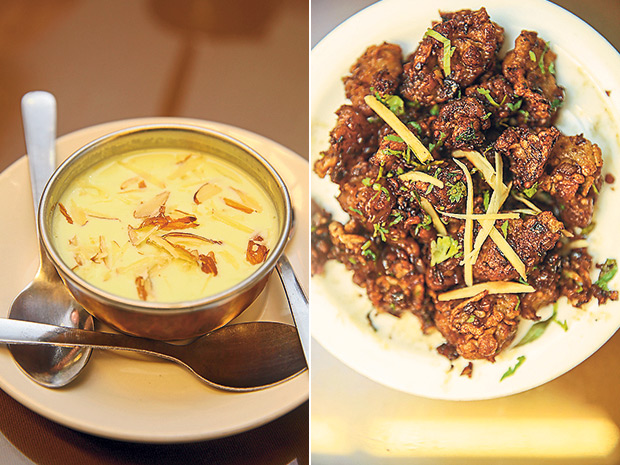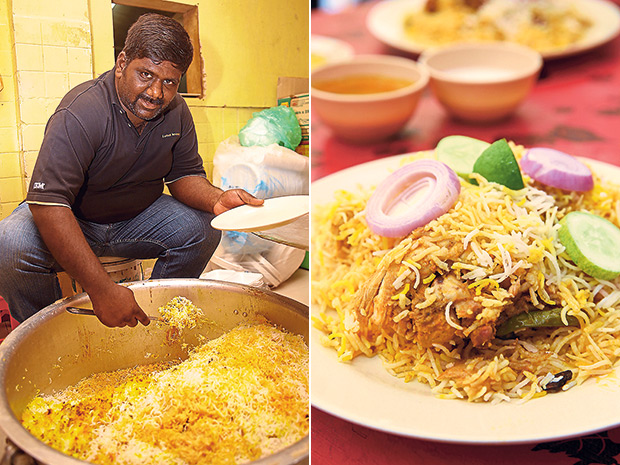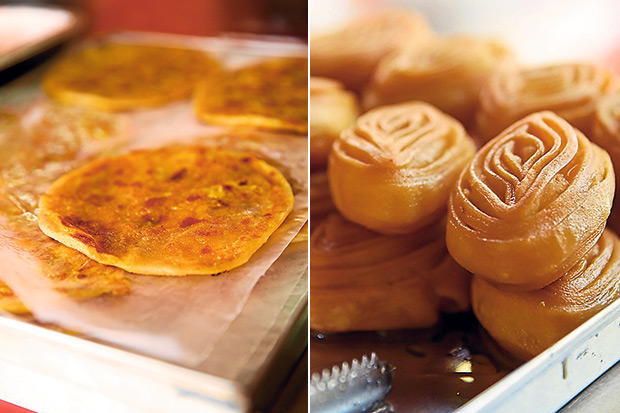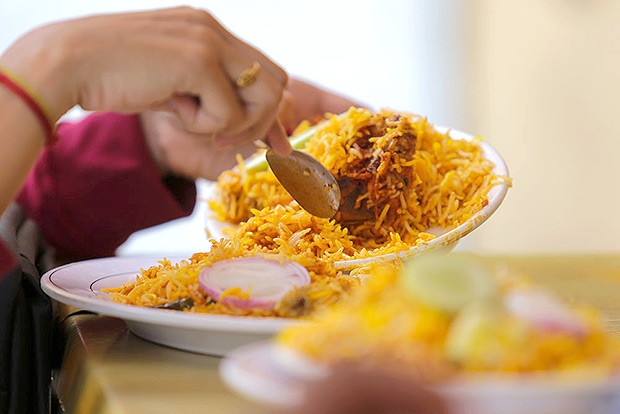KUALA LUMPUR, May 22 — Biryani which is much more than just rice and meat cooked together with spices is often called the king of dishes. Its origins can be traced to Turkey and Persia.
The sumptuous dish requires careful layering of rice with marinated meat to create a sumptuous dish of beautiful fragrant long fluffy grains with tender meat. There are many regional variations but the biryani from the city of Hyderabad is the most well known.
So, we set ourselves a mission... to seek out the best Hyderabadi biryani in KL. Accompanying us on this food escapade is Hyderabad native Nazeen Koonda who works as a freelance communications, public relations and social media specialist.

She’s been in Malaysia for about seven plus years. She is a passionate food lover who is mad for biryani so she was the perfect person to clue us in on what is Hyderabadi biryani and what a good version should taste like.
Nazeen explains that the Hyderabadi biryani is prepared by layering marinated raw meat and 40 per cent cooked rice in a pot. One of the revered chefs in Hyderabad, Nawab Mehboob Alam Khan, uses copper pots to cook his biryani over a charcoal fire for a far superior taste.
He uses papaya juice to tenderise the meat. The meat is also mixed with ginger garlic paste, salt, turmeric, red chillies, whole spices like cinnamon sticks and cardamom, fried onions, yoghurt curd, lemon juice, chopped herbs like mint, coriander and green chillies, and peanut oil.
It’s left to marinate for about one hour before partially cooked rice is placed on top of it. The rice is sprinkled with ghee combined with the water reserved from boiling the rice.
Lastly, saffron is mixed with milk — to give it a richer taste — and poured over the top part of the rice to give it the distinct yellow colour. The pot is sealed with dough made from wheat flour and water to keep the steam inside it.
Nawab adds hot coals on top of the lid to evenly cook the biryani. “Once the dough is cooked, you will know it’s ready and when you open it, oh man!”, explains Nazeen. Another version that takes a shorter time is the semi-cooked style where the meat is marinated and cooked first, then layered with rice and cooked in a pot sealed with dough or dum style.
The hallmark of an excellent biryani is the fluffy rice grains. “It has to be the perfect balance with the rice, meat and spices,” explains Nazeen. If there is too much of the masala mixed with the rice, it becomes clumpy and it’s not biryani.
Instead, as Nazeen emphasises, it resembles a pulao where the meat and rice are just cooked together, which is what is usually served in restaurants in KL under the guise of biryani.
Traditionally the biryani is accompanied by mirchi ka salon (green chilli curry) or bhangra baigen (eggplant curry). It also comes with raita or yoghurt to temper the spiciness of the biryani.
On the side, you usually have a salad of sliced raw onions and cucumbers with a wedge of lime. Squeeze the lime over the onions to give it a tangy taste; this helps to cut through the richness of the biryani. The best way to enjoy the light fluffy biryani is to eat it on its own unadulterated, explains Nazeen.

Our exploration starts with Hyderabad Biryani House run by Saira Banu, a Malaysian who is married to a Hyderabad native. She is assisted by her Malay sister-in-law, Fauziah Mat Nasir.
Nazeen is so excited to try the biryani that she woke up at 5.30am thinking of it! Verdict? She’s happy with their biryani that is also less oily. “The rice is spot on and spice wise it’s good.”

According to Saira, she uses the pricier Koohinoor brand for basmati rice from India that doesn’t need to be pre-soaked to get the long fluffier grains. She had specially brought in a chef from Hyderabad just to cook the biryani. She also uses selected spices from Malaysia and imports some items from Hyderabad like the lemon salt and saffron.
Accompanying the biryani, you have a peanut curry that has turmeric and raita. We felt the curry and raita were a little too watered down as the flavours were incredibly muted. It may be better to pair the biryani with their spicy brinjal kurma from the counter.

On Friday, Saturday and Sunday, they also serve one of their crowd favourites, the gongura mutton that is cooked with mutton and the sour tasting gongura leaves.

On a daily basis, there’s chicken biryani (RM12), egg biryani (RM9) and plain biryani (RM8). On Friday, Saturday and Sunday, you can enjoy the mutton biryani (RM15) and a vegetarian biryani (RM8).
There’s also fish biryani that uses tenggiri fish which is made only upon order. A minimum order of five portions is needed for the fish biryani. Each pot of biryani is cooked fresh daily twice a day for lunch and dinner. Any leftovers are donated to the homeless.
Originally the restaurant was located at the Section 7 Shah Alam food court when it first opened in 2012. Following a dispute with the local partner who wanted to change its original taste to suit local tastebuds, they relocated in 2013 to the present premises in Brickfields. Last January, they expanded their business to a food court in Batu Tiga Shah Alam.

On Friday, Saturday and Sunday, complete your meal here by looking for their popular dessert, double ka mitha. Essentially it’s bread soaked with cow’s milk and served with almonds, raisins and cashew nuts. It’s topped with pheni, a type of vermicelli that is made from maize flour and starch.

For the upcoming Ramadan, Saira confirms that they will be serving haleem that has a sticky dodol-like consistency with a savoury taste which takes up to eight hours to cook!

Our next stop is Restoran Hyderabad Recipes. It’s a bit posher since it is a proper restaurant with air-conditioning. The eight-year old restaurant is run by Saiful Islam and their cooks hail from Hyderabad and New Delhi.

According to Saiful, this is now their sole outlet. Previously they had expanded up to eight outlets all over the Klang Valley but they have now shut them down due to a drop in business. The restaurant has also changed owners and is now owned by a Malaysian.
Every day, they cook mutton biryani and chicken biryani dum style using the Mohgul brand basmati rice. It is cooked twice a day; first at 10am and again at 4pm to 5pm.
There are many versions of biryani but some are cooked only upon order, like their fish biryani and prawn biryani. We order the Hyderabadi special chicken biryani and mutton biryani. It’s RM21.90 per portion.

The biryani is laden with tender mutton pieces and chicken pieces. However, the rice tends to be clumpy and slightly heavier from the oil. Their saving grace is they serve bhagare baingan, a delicious eggplant curry to accompany the biryani.
Saiful advices that the biryani they serve is medium spicy to suit diners in the area. Most of their clientele are tourists who can’t take the spiciness. If you prefer a spicier biryani, just ask the server and they’ll scoop the bottom part for you that is spicier.
There’s an extensive menu of items like their masala kulcha and garlic butter naan which is delicious with their aromatic chicken curry. Popular items include their achar, gobi manchurian, bhindi masala and aloo gobi as advised by Saiful.

For dessert, if it’s available order the qhubani ka meetha made from dried apricots. We try their badam kaddu kheer, a refreshing cold sweet.
Last but not least, we swung by A P Bhavan Restaurant on a Sunday. Appearances can be deceptive as I’ve walked past thinking there aren’t many patrons here at this quiet looking place. From what I understand, most of their regulars usually pack back their biryani. Moreover, most people sit in the air-conditioned room hidden from the public view.

The five-year old place is managed by Krishna Chatanya who hails from Hyderabad. He also helps out with the cooking. Every day, they serve chicken biryani (RM11). For Friday and Saturday, there’s vegetarian biryani (RM9). On Friday and Sunday, they serve their special mutton biryani (RM16). The special mutton version uses boneless mutton pieces that are marinated with spices for one hour.
On Friday, the mutton is cooked together with the rice dum style while on Sunday, the mutton is cooked separately from the rice. According to Krishna, when the meat is cooked separately, you can make it spicier. Usually when it’s cooked dum style, you cannot laden the masala with the meat or else the rice will be too clumpy.

After tasting the biryani, Nazeen is of the opinion that this version is leaning towards the Andhra style as it’s spicier with the use of green chillies and it is also a bit wetter.
The biryani is served with a curry that is rich with coconut, cashew nut paste, spices and coriander powder. It’s sometimes cooked using a chicken broth made with chicken bones that makes it even tastier.

Also on the side, you have a thick raita with chopped cucumbers. On weekdays, the biryani is cooked twice a day, once at 12pm and for the night session, at 7.30pm. On weekends, they cook the biryani three times a day; 12pm, 2pm and 7.30pm.
For lunch, the restaurant delivers to selected places in KL like Bangsar South, KL Sentral, Masjid Jamek, Maybank Takaful in Bangsar and Technology Park Malaysia. Place your order before 11.30am. The minimum order is for five portions of biryani and there’s a RM1 delivery fee levied on each biryani order.
Previously, they had five outlets all around the Klang Valley but now they are left with this outlet and another eatery that is located within Palm Court apartments. It’s open from 7am to 10pm and serves Indian food items like thosai and roti canai.

Once you are sated with the biryani, cool off with the selection of sweets like kaja, badsha, jelebi and poli that is available every day. The pretty spiral like kaja and the plainer badsha are made from flour and ghee that is deep fried and dipped in syrup.

Unlike the bright orange jelebi we often see in Indian shops, this version uses no colouring. There are two variations; one uses normal sugar while the other is made from jaggery. Both are not overly sweet and crispy. My favourite is the simple unassuming looking poli (bobbatlu in Telegu). Essentially it’s chapati with a sweet tasting chana dhal and jaggery filling. It’s absolutely delicious and calls for a second helping.
In conclusion, each of the places seem to have their own variations of Hyderabadi biryani to suit different tastebuds. The one from Hyderabad Biryani House trumps the others in terms of fluffy long rice grains even though its peanut curry and watered-down raita are less impressive.
This would suit those who prefer a drier version of biryani. Alternatively, they may enjoy their meal better if they swapped the peanut curry for one of the curries from the counter.

For a slightly wetter biryani paired with a fragrant curry infused with coconut and thicker raita, A P Bhavan is a better choice. Last but not least, the biryani at Hyderabad Recipes may be clumpy and not as fragrant compared to the other two places but it’s the only place that serves their biryani with the fragrant bhagare baingan.
Also note that most of the portions for biryani are good to be shared between two or three people. If you prefer, pack home the biryani and freeze it. Nazeen advises that it’s best to pack it when the biryani is cooked fresh from the pot. Leave it to cool to room temperature and freeze.
You can defrost and reheat later. When you pack the biryani home, the flavours tend to develop more too, giving you a more aromatic biryani meal to enjoy in the comfort of your home.
A P Bhavan Restaurant
No. 70 & 73, Jalan Berhala
Off Jalan Tun Sambanthan, Brickfields, KL
Tel: 03-2631 6149 /
014-680 9824
Open daily: 11.30am to 11pm.
Hyderabad Biryani House
No. 46, Ground Floor,
Jalan Berhala
(Opposite lane to Palm Court Block D)
Brickfields, KL
Tel: 03-2260 7036
Open daily: 6.45am to 10.30pm. Lunch is served from 11am and dinner is served from 7pm onwards.
Restoran Hyderabad Recipes
78-1, Jalan Putra
(near PWTC), KL
Tel: 03-4044 7786
Open daily: 10am to 12am.






















